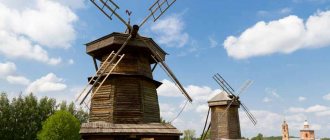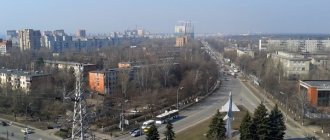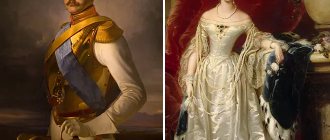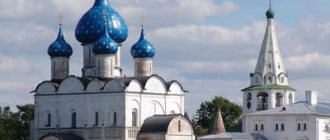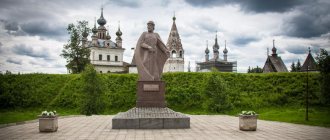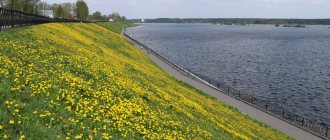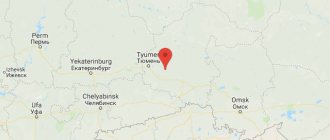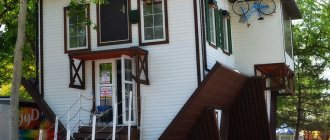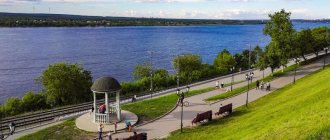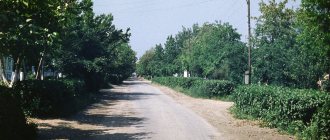Suzdal is one of the most beautiful cities of the Golden Ring . I've been here more than once before. But those were short day trips. And at the end of May last year I came here for three whole days! It seemed to me that this would be enough time to explore the entire city several times. However, it turned out that this time was not enough to see all the sights!
♦ On topic: Excursions to the cities of the Golden Ring of Russia
Suzdal Kremlin and Ilyinskaya Church from the Ilyinsky Meadow
Suzdal Kremlin
Suzdal Kremlin
Vladimir region
The Suzdal Kremlin was built in the 11th–12th centuries to protect the city from enemies from the east, south and west. On the northern side of Suzdal, the enemy’s path was blocked by the Kamenka River. The Kremlin was surrounded by earthen ramparts more than a kilometer long; gates, towers and log walls were built on them. The ruins of ramparts and ditches have survived to this day.
The most ancient building of the Suzdal Kremlin is the Cathedral of the Nativity of the Virgin. It was built in the 13th century under Prince George Vsevolodovich. In the 17th century, stone buildings of the Bishops' Chambers were erected in the center of the main square of the Kremlin, which included residential and utility buildings. Until the end of the 18th century, the Suzdal Kremlin served as the residence of the Vladimir-Suzdal bishops. Today it is a museum complex, a monument of ancient Russian art and architecture.
Tips for staying in Suzdal
The best time to come to Suzdal is in the summer: you can calmly explore all the ancient buildings, admire the picturesque view, and also take a boat ride on the river.
Getting around by personal transport in the city is not entirely convenient, since there are almost no parking lots, and if there are any, they are only small. Public transport in Suzdal is represented by buses and minibuses, which operate from 6.00 to 23.00.
There are many hotels in Suzdal - you can find one suitable in terms of comfort and price
Holidays in Suzdal are an expensive pleasure. Prices per night in a hotel are the same as in the capital, and the average bill in a cafe is about 1,200 rubles.
Suzdal is famous for its religious monuments, so you can bring souvenirs related to Orthodoxy from here: crosses, icons, the Bible. Local shops also sell products made from birch bark: bast shoes, caskets, baskets, boxes.
Spaso-Evfimiev Monastery
Spaso-Evfimiev Monastery in Suzdal, Vladimirskaya…
Vladimir region
The monastery on the high bank of the Kamenka River was founded by Suzdal and Nizhny Novgorod prince Boris Konstantinovich in 1352. When the first abbot of the monastery, Evfimiy, was canonized as an all-Russian saint, the monastery received the name Spaso-Evfimiev. In the 17th century, the wooden monastery buildings burned down during the Polish-Lithuanian invasion, after which the monastery began to acquire powerful defensive towers. By the end of the 17th century, the Spaso-Evfimiev Monastery was one of the largest in Russia.
In 1766, by decision of Catherine II, a prison for political and mentally ill prisoners was established in the monastery. In the 20th century, a political detention center was located here, and then a testing and filtration camp, through which more than 8 thousand people passed. Until the 1960s, there was an educational and labor colony for juvenile delinquents on the territory of the monastery. Only in 1968 the Spaso-Evfimiev Monastery became a museum. Today it is part of the Vladimir-Suzdal Museum-Reserve, and its exhibitions introduce the history and culture of the Suzdal land.
Suzdal
How to have time to see all the sights and try interesting tourist activities in Suzdal? We have compiled a list of things that you need to do in Suzdal in order to confidently say that you have experienced the city and examined it from different sides.
View of Suzdal from the Venerable Bell Tower
© Olga Kvesisskaya
View of Suzdal from above . The best option is from the bell tower of one of the churches. The most spectacular places are: on the belfry of the Venerable Bell Tower (the highest), on the high bank of Kamenka near the walls of the Spaso-Evfimiev Monastery, on the Kremlin ramparts, on Kabatskaya Mountain and Ilyinsky Meadow.- Become a Russian folk master . Craft shops in Suzdal offer master classes on making dishes, toys and other crafts. For example, the Dymov Ceramics factory conducts tours of the production with a master class on clay modeling.
- Try on outfits from past eras . The city's museums (Shchurovo Settlement, the Museum of Wooden Architecture) offer photo sessions in historical costumes. Local photographers also offer similar services. You can try on the outfits of the inhabitants of Ancient Rus' or the townspeople of the 18th–19th centuries.
- Try Suzdal mead . The Suzdal mead factory produces drinks according to old recipes and with new, more exotic tastes. In summer, it’s worth taking a bottle of sea buckthorn mead for a picnic, and in winter, warm up with a drink with rosehip or juniper flavor.
- © Valeria Belousova
Ride a trio of horses . Horseback riding around the city in Suzdal is very colorful. You will be taken for a ride in a carriage or chaise (in winter in a sleigh) on three horses with bells. As a rule, these are short walks around the city center. But you can also book a trip for a few hours and sweep through Ilyinsky Meadow with the breeze. - Take a selfie with Prince Vladimir or Peter I. The Suzdal Wax Museum (a branch of the Moscow Museum) displays figures of famous rulers from the times of Ancient Rus' to the present day, as well as film characters and famous writers.
- Attend a church service . In Suzdal, a city with the largest concentration of churches per square kilometer, it is definitely worth attending a festive service, even if you are not a religious person. This is a very solemn process that has not changed for many centuries.
Guide
Travelers most often explore compact Suzdal chaotically, missing out on some interesting places due to the lack of a well-thought-out route. Depending on your interests, a walk around Suzdal can be focused on a specific historical era, or have a cinematic or religious twist.
Route 1: North to South
The classic route around Suzdal covers all the main attractions. The walk takes from a couple of hours to half a day (if visiting museums). You will see:
Monastery of Saint Euthymius
© Alexey Buchanov
- Monastery of Saint Euthymius. The museum complex with powerful fortress walls and ancient temples is the starting point of the route.
- Posad house. The oldest residential building in the city can be viewed from the outside, or you can visit the museum exhibition inside.
- Alexander Monastery. Founded by Alexander Nevsky in the 13th century, it was rebuilt in the 17th century.
- Deposition of the Robe Convent. On its territory there is the highest observation deck in Suzdal - in the Reverend Bell Tower.
- Trade area. The atmosphere of the square takes us back to the 19th century: with authentic shopping arcades, horse-drawn carriages and ringing bells.
- Suzdal Kremlin. The museum complex on the earthen rampart includes ancient churches made of stone and wood and several historical exhibitions.
The route ends in the historical center - after the walk you can go for souvenirs at Gostiny Dvor or for lunch at one of the Russian restaurants. If you wish, you can continue your acquaintance with Suzdal by taking the second route.
Route 2: Right bank of the Kamenka River
The right bank of Kamenka, less popular among tourists, is a calmer and more secluded place. Here you can enjoy the nature of Suzdal land, without haste and crowds of tourists, explore ancient sights.
- Museum of Wooden Architecture
© Vladimir Shefer
Pokrovsky Monastery. The first point of the route is an ancient monastery behind white stone walls, in which princely and royal wives who were disliked by the rulers were kept.
- Ilyinsky meadow. In the Ilyinsky Meadow reserve you can walk along an ecological trail and see several churches in the surrounding area: Ilyinskaya, Tikhvinskaya and Epiphany.
- Museum of Wooden Architecture. In the open air there is an exhibition of ancient residential buildings, wooden churches and peasant household buildings: mills, barns.
You can complete the excursion route along the right bank with a boat trip on a river bus along Kamenka. The route takes 45 minutes - you will get from the Museum of Wooden Architecture to the Spaso-Evfimiev Monastery.
Route 3: Suzdal to the cinema
Scenery in the Shchurovo Settlement complex
© Maxim Yashkin
Not your first time in the city? Look at already familiar landmarks through the prism of art. Suzdal has acted as a setting in several dozen films. Fans of Soviet and modern Russian cinema should walk around Suzdal, examining places from their favorite films and guessing scenes.
The film route through Suzdal passes through: “Shchurovo Settlement” and the Spaso-Evfimiev Monastery (the location of the filming of the film “Tsar”); Alexander and Robozhensky monasteries, Misha Balzaminov’s house and Torgovaya Square - the Soviet film “Balzaminov’s Marriage” was filmed in these places; then visit the Suzdal Kremlin, where the film “The Tsar” was also filmed, and complete the route at the Museum of Wooden Architecture, which served as the backdrop for the film “Finist - the Clear Falcon.”
Detailed material: What to see in Suzdal in a day
Event tourism
Suzdal is an ideal place for holding historical festivals dedicated to the culture of Ancient Rus' and colorful folk fairs. Throughout the year, national holidays are held here on a truly Russian scale. Some events are international in nature. What festivals and holidays in Suzdal are worth visiting?
The Goose Fights festival is held in Suzdal in February-March. For the fights, geese are brought from the city of Pavlovo, Nizhny Novgorod region. In addition to exhibition fights, there is a fair and performances by folk groups.
The Russian Animated Film Festival is the largest annual show of Russian animation. The festival takes place in March. The program includes screenings of animated films, master classes from recognized animators, and performances by musical groups.
Cucumber Day
© Elena Akimova
The Russian stove festival is held in the Suzdal region at the end of May at the “stove-benches” hotel complex. The program includes: tasting of Russian cuisine from the oven - cabbage soup and porridge; craft and culinary master classes.
Rusal Week is one of the most mysterious holidays of Ancient Russia. A festival dedicated to this pagan celebration is held in Suzdal. Guests can see revived rituals, listen to ancient songs, dance in circles, tell fortunes on wreaths and jump over a fire.
Blues Bike Festival is an international music festival, one of the main events of the summer motorcycle season. Held in July. The festival's musical program includes performances by the best bluesmen of Russia and other countries. One of the main events of the festival is a colorful custom show.
Cucumber Day in Suzdal is one of the most famous holidays. It is held in mid-summer. This unique holiday is remembered by visitors thanks to unusual competitions: for the best cucumber dish and cucumber costume, and the most unusual vegetables from local farmers. At the end of the holiday, a cucumber doll is sent into the sky in balloons.
The Laptya holiday “Suzdal Versta” is another unusual July holiday. The main event of the festival is the sandals race. Also, participants in bast shoes play football, long jump and carry firewood.
Cucumber Day in Suzdal
© Alexey Buchanov
The street theater festival takes place in Suzdal in August. In the open air, in the scenery of the historical center, festival guests can see theatrical performances of various genres: from musical to puppet shows.
The knightly tournament “Golden Sword of Russia” is a week of reconstructions of knightly battles in Suzdal. The battles take place according to the canons of a medieval tournament. These include classic walking and shooting tournaments, as well as crossbow competitions.
The folklore festival “Men's Games” is held in the fall on the territory of the Museum of Wooden Architecture. It is part of the ethnographic festival “Heroic Fun”, which is held in different cities of the Vladimir region. Participants compete in such exotic disciplines as tug-of-war with a horse; rental of a cart loaded with grain; transfer of a well frame.
The “Medovukha Fest” festival is one of the most famous gastronomic festivals in Russia. The festival brings together mead producers from different cities of Russia. Here you can taste the unusual tastes of the drink and try dishes whose main ingredient is honey. In addition to the exhibition fair, culinary and craft master classes, competitions and a show program are held.
The Euphrosyne Fair takes place in Suzdal after the harvest, in October. On the Trade Square there are rows with products from local farmers and folk craftsmen. Competitions and lotteries are held, and folk music groups perform.
Seasonal holidays
The Suzdal climate, familiar to most Russians, is favorable for travel all year round. Every season Suzdal reveals itself differently. Both in winter and summer, you can find interesting activities in the city and its surroundings, take part in vibrant festivals and folk celebrations.
Suzdal at Christmas
© Lyudmila_Klyopova
Winter
Moderately frosty winter in Suzdal is a postcard time of year. Smoke rises from chimneys over the city, church domes shine in the bright sun, and the clatter of hooves and the sound of bells can be heard in the ancient streets. In the Suzdal scenery, it is especially pleasant to indulge in winter fun - sledding from the Kremlin ramparts or snowmobiling along the frozen Kamenka River. Dog sledding is organized at Shchurov Gorodishche. You can go skiing at the Zayachya Gorka complex, a 20-minute drive from Suzdal. A more varied selection of slopes is available at the Puzhalova Gora ski complex, located 180 km from Suzdal.
Detailed material: What to see in Suzdal in winter
Spring
In the first half of spring, Suzdal is a quiet and sleepy provincial town. During this period, you can enjoy the absence of tourists and peaceful views. The weather can be unpredictable - but in case of rain or unexpected snow, Suzdal has interesting museums and cozy restaurants.
By the May holidays, the weather in Suzdal becomes warm and suitable for picnics. The city is filled with tourists. The cost of holidays during the May holidays increases significantly. When planning a trip for May, choose the second half - there will be much fewer tourists and better prices.
Summer
Boat trips on Kamenka
© Alexey Buchanov
Summer in Suzdal is high season. This is the time of festivals and folk celebrations. In June, it is worth visiting Suzdal during Rusal Week and taking part in Slavic rituals. In July, tourists flood the city during Cucumber Day. The main event of August is the street theater festival.
In the summer, boat trips along the Kamenka River are organized in Suzdal. This can be not only a river bus, but also a popular SUP board or kayaking tour. You can swim on the city beach near the Suzdal Hotel or go to Kideksha. There, on the Nerl River, there is a sparsely populated beach overlooking an ancient temple. For a camping holiday in the Vladimir region, choose the picturesque Meshchera National Park, the nature of which was sung by many Russian writers.
Detailed material: What to see in Suzdal in summer
Autumn
Suzdal is worth visiting in the first half of autumn. In mild and sunny September, Suzdal looks especially poetic: there are no noisy crowds of tourists, the heat of the day has subsided, the streets are deserted, and the falling asleep nature is especially beautiful. The navigation season on Kamenka lasts until October.
In the second half of autumn, the weather in Suzdal is not very picturesque: cold rains give way to frosts and snow. In October-November, walking around the city is reduced, but the time spent in restaurants tasting original dishes of Russian folk cuisine increases.
Party places
Suzdal is usually chosen for peace and enjoyment of the culture of Ancient Rus'. The town is not famous for its noisy parties and abundance of nightlife. But this does not mean that the streets of Suzdal die out in the evening. There are several places in and around the city where you can organize a fun evening out.
Most nightlife establishments in Suzdal are located in hotel complexes. In the hotel and tourist complex "Suzdal" there is a karaoke bar open until the morning, there is a bowling alley and saunas. The Day and Night restaurant at the Suzdal State Tourist Complex hosts live music evenings, and a dance floor opens in the evening. There is a restaurant with a dance floor at the Nikolaevsky Posad art hotel. Another karaoke bar operates at the Lepota eco-hotel. At Tavern on Vasilievskaya you can not only have a hearty lunch, but also dance in the evening.
The Smile nightclub is located on Central Street. This is the most popular night spot. Tourists praise the cocktails in the club bar, but the atmosphere seems outdated to them, compared to clubs in large cities. The Night Watch bar has a more intimate and calm atmosphere. People come here to spend a cozy evening listening to unobtrusive music.
Vacation with children
Mini-zoo in “Shchurov Settlement”
© Maxim Yashkin
In Suzdal you can organize a family vacation to suit every taste. Fans of active outdoor activities in the summer should go on a bike or boat trip with the whole family and have a picnic in the most picturesque place. In winter, this could be riding a husky sled or in a carriage pulled by three horses. The Yamskoy Dvor complex offers horse or pony rides. Active leisure can be organized in the Shchurov Settlement: here children can shoot a bow or learn sword fighting. There is also a mini-zoo with pets in the Shchurov Settlement. The second petting zoo is located near the M-7 highway, at the Pechki-Lavochki tourist complex.
In the city center, next to the Trade Rows, there is a children's playground with wooden slides and swings. Several playgrounds for children of different ages are equipped in the 950th anniversary of Suzdal park. You can also rent a bicycle, scooter or roller skates there. Another fairly large wooden playground for children is located on the territory of the Pushkarskaya Sloboda hotel - entry to the territory is free.
© Olga Kvesisskaya
It is more interesting for children to walk around the city with some purpose or mystery. You can go with your whole family on “City Quest” - an interactive tour of Suzdal. Guides dressed in costumes of past centuries accompany tourists in search of the treasure of Yuri Dolgoruky. Participants will visit the main attractions of the city, unravel its secrets and, at the end, receive memorable souvenirs. Fans of modern technology can go on an aerial tour of Suzdal: wearing special virtual reality glasses, children will “fly” over Suzdal in 16 minutes and see all the city’s sights from the air.
Another interesting leisure option with children is creative master classes. In your free time from excursions, go to one of the craft workshops in Suzdal. Depending on your child’s interests and skills, this could be: painting a fresco in an icon-painting workshop, pottery lessons, forging a nail in a forge, making dumplings or baking pretzels, weaving from birch bark, making nesting dolls or patchwork amulets. By the way, you can invite artisans in Suzdal to your hotel for an individual or family master class.
Detailed material: Holidays with children in Suzdal
Museum of Wooden Architecture
Museum of Wooden Architecture in Suzdal
Suzdal district
The Museum of Wooden Architecture and Peasant Life is a complex of architectural monuments in the open air. The museum's exposition reproduces a small village with huts, churches, outbuildings and windmills of the 17th–19th centuries, which were brought here from different parts of the Vladimir region.
Two temples, built without a single nail, rise above the recreated village. Here you can see the hut of a simple farm laborer, a wealthy peasant and a merchant. The interiors of the huts contain samovars and furniture, dishes and toys, wooden spinning wheels and looms.
Suzdal during the reign of Andrei Bogolyubsky
Dolgoruky's son Andrei Yuryevich, nicknamed Bogolyubsky, makes Vladimir the capital city of the principality. Following the example of his father, who built Kideksha, he also builds himself a country residence-castle: Bogolyubovo at the mouth of the Nerl. Construction of majestic white-stone churches and buildings is underway both in Bogolyubovo and in Vladimir. Bogolyubsky is also “fighting” Kyiv. But his policy is fundamentally different. A wise man and politician, he is actively looking for ways to overcome the fragmentation of Russian lands, princely civil strife, and strives to concentrate all power in one strong hands. The prince is guided exclusively by all-Russian interests. So, he came to Kyiv at the head of the united troops of eleven feudal lords in order to finally establish the significance of the new political center.
The Vladimir-Suzdal principality is gradually becoming the center of Russian life; culture and art are flourishing here. The new capital of the principality, Vladimir, is being rapidly built up, and Suzdal seems to be relegated to the background. But secular hierarchs still pay a lot of attention to him. Under Grand Duke Vsevolod III, the Nativity of the Mother of God Cathedral, the main temple of the city, was rebuilt and decorated; the territory of the Kremlin is surrounded by new fortifications; the earthen ramparts became higher and more powerful; a wooden fence with 15 towers was later built on their crest. The main one, Ilyinskaya, acquired a beautiful finish in the form of a double-headed gilded eagle.
Temple of the Resurrection of the Word from Patakino in the Museum of Wooden Architecture
Temple of the Resurrection of the Word from Patakino in the Museum of Wooden…
Vladimir region
The Church of the Resurrection of the Word was brought to the Museum of Wooden Architecture from the village of Patakino. The church was erected in 1776, it was consecrated in honor of the Resurrection of Christ. At that time, the temple belonged to the landowner Ivan Akinfov. For a long time, the wooden church served as a cemetery church, which was assigned to the Trinity Stone Church in the village of Patakino.
The structure has the architectural shape of a ship - the altar, bell tower and western porch of the church are built along the same axis. The Church of the Resurrection of the Word became an exhibit of the Museum of Wooden Architecture in 1969–1970. Its restoration was carried out by the architect Valery Anisimov.
Northern capital of Yuri Dolgoruky
Nobody knows exactly when Suzdal was born. The history of his name and appearance is a mystery. Old Russian historical sources remember it as an already existing city at the end of the 10th - first half of the 11th century. More than a thousand years ago there was already a fortress with earthen ramparts here, and there was a trade going on.
xavi/www.flickr.com
The North-East of Rus' is often called the Rostov-Suzdal land or the Rostov-Suzdal principality. This name shows the primacy of Rostov, an even more ancient and once stronger urban center. Rostov the Great has long been considered the capital of the entire colossal region.
However, in the middle of the 12th century, Suzdal bypassed it. The city began to grow rapidly and become rich. The era of Suzdal's greatness lasts, interrupted, for more than two hundred years and ends at the end of the 14th century, when the city bowed its head to the power of Moscow.
Photo by Ekaterina Sokolova
The rise in the fate of Suzdal is associated with the activities of the restless, enterprising Prince Yuri Vladimirovich, nicknamed Dolgoruky.
Yuri Vladimirovich ruled the vast Rostov-Suzdal land for several decades. Later, it was from here, from the northern forest region, that the state of Russia would grow. But in the first half of the 12th century, the Rostov princely “table” was much inferior in honor to the South Russian ones. Wilderness, wildness, incredible distance from the key areas of ancient Russian culture and politics. It is impossible to say when exactly Yuri Vladimirovich settled there. Various assumptions have been made, but there is no date in the sources, and there is no way to determine it even approximately.
Photo by Ekaterina Sokolova
After the death of the eldest son of Vladimir Monomakh, the outstanding politician Mstislav the Great, a large princely feud began (1132). Yuri Dolgoruky also took part in it. He captured Pereyaslavl South by force, throwing out his own nephew from his reign there. But since he established himself in the city unlawfully, after eight days of reign he himself was forced to leave.
Three years later, Yuri finally received Pereyaslavl from his older brother, giving him in return part of his northern “patrimony” - Rostov and Suzdal. After all, the large fortress in the south, the rich Pereyaslavl, is a much more “honest” reign than the forest wilds on the outskirts of Rus'. The main life was concentrated in the Kiev region, where the main crossroads of the great strategic “game” remained. And Pereyaslavl stood next to Kiev, not like Rostov and Suzdal - outer darkness... Yuri Vladimirovich neglected them.
Photo by Ekaterina Sokolova
Prince Yuri again did not stay long in Pereyaslavl. The vicissitudes of a long inter-princely strife forced him to leave the Pereyaslav “table”. He had to return to the unfavorable northern expanses. In 1137, he left Southern Rus' for Rostov and again reigned in the Rostov-Suzdal land. And a few years later he changed his capital: by the mid-1140s, instead of Rostov, Suzdal became one.
That's when the rise of the city begins. Yuri Vladimirovich is building his residence with the white stone Boris and Gleb Cathedral not far from it, in Kideksha. The boyars and his warriors receive land in the nearest villages, on rich fertile land. The “aristocratic” treasures found many centuries later by archaeologists, including a set of precious gold bracelets, date back to around this time.
Photo by Ekaterina Sokolova
The wooded, distant, but rich outback quite suited the prince's faithful servants. But his heart belonged to the south. Several times he left this land to wage an armed struggle for the Kiev grand-ducal throne. But in the Kiev region they did not know and did not like the northern prince. The people there kicked him out even when the power of the sword brought him success. Meanwhile, having ruled this great city twice briefly, Yuri Vladimirovich could not overcome the desire to reign there again.
Having once again suffered defeat and established peace with his political rivals, he decided to break these obligations for the sake of the illusory hope of recapturing Kiev. His own son Andrei, a faithful assistant, a brave commander, left him in anger. He told his father: “We kissed the cross that you would go to Suzdal!” And Andrei Yuryevich, keeping his oath, went to his northern estate on Suzdal land. He was no longer interested in further squabbling over Kyiv. He turned out to be wiser than his parent: he was still forced by armed force to go to the North.
Photo by Daria Barinova
Has the father himself reconciled? Did he want to calm down with that?
Nothing happened. He tirelessly threw the strength of the Suzdal squads to the south. In 1154-1155 the last act of the titanic struggle for Kyiv took place. The dream of the great stubborn man came true: he nevertheless took the grand-ducal throne. But the Lord himself set a limit to his pride - the prince did not enjoy his triumph for long. On May 15, 1157, the sovereign of Kiev, who participated in many battles, ended his days peacefully.
Does anyone now remember the campaigns of Yuri Dolgoruky, his struggle for Kyiv, quarrels with his relatives? Apart from specialists, and perhaps even the most meticulous lovers of historical knowledge, no one.
Photo by Daria Barinova
But this figure is truly famous. But what brought Yuri Vladimirovich fame was not what he himself probably considered his life’s work - the capture of Kiev. His useful undertakings related to the reign of the prince on the unloved Rostov-Suzdal land were glorified. Yuri Vladimirovich built an incredible amount. With a generous hand, he founded new cities, erected fortresses, and erected temples. Not being attached to his northern patrimony, he still behaved there like a real master.
Under him, a stone Church of the Savior was erected in Suzdal itself, and the land of Suzdal was decorated with new cathedrals and cities.
